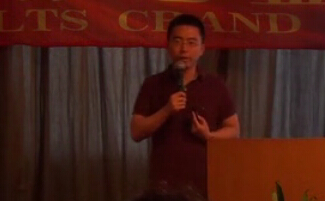雅思阅读材料之蜘蛛是怎么织网的
2014-01-21 13:59 供稿单位: 新航道
出国英语考试有哪些 雅思6.5是什么水平 雅思阅读评分标准 托福阅读评分标准 雅思和托福的区别
To spin a tale about the spider, an arachnid, we must first examine the common thread that ties them together...the way they produce the silk they use to weave their webs, as well as other contraptions, to suit their particular needs.
Spiders differ from insects in that they have eight legs, eight eyes, in most cases, no wings, and have only two parts to their bodies, one of which produces silk. They are found in a host of climates, can scurry across the ground, can scale plants, and can skate on, and live in, water. These factors determine how the spider uses it's silk, and what type of silk it produces.
The production of silk begins in certain glands located in the abdomen, or belly, of the beast. Spinning organs at the tip of the abdomen, contain many tiny holes, and function much as a sieve, through which the silk is pressed. The silk strained through is in liquid form, but immediately takes on a solid form, much like cotton candy does, when exposed to air.
The spider creates a variety of types of silk, each of which serves a separate, yet distinct function. Spiders use the sticky kind to spin webs, to catch and to hold the insects they invite into their parlors until they are ready for dinner. They use the non-sticky, stronger variety to tether down the spokes of the wheel, and yet a different kind of silk for their cocoons.
Even the webs the spider spins differ greatly, depending upon the factors listed above. The most common of all webs we see is the wheel-shaped web. Less common are the so-called "sheet" webs, which blanket surfaces with a funnel, or dome like shape. The trap-door spiders burrow out their webs, and complete them with built-in chutes, through which their unsuspecting guests fall through, right onto the spider's plate. The web we see least often, is the air-tight, bell-shaped home some spiders build...probably because it is completely submerged in water!
Why aren't spiders caught in their own webs?
In short, startled spiders can be entangled in their own webs, in the same manner as their prey. Generally speaking, however, the spider avoids this deadly mishap, by differentiating between the various types of silk it produces, and by knowing its home turf.
When the spider weaves its sticky, insect-catching type of web, it builds into it safety threads of the non-sticky variety, upon which it traverses without being snared. Its nimble, highly sensitive feet orient the spider about its new home, and past the potential pitfalls, to which its prey falls victim. Unless, of course, something, or someone, startles the spider, in which case all bets are off, and the parlor game is over.
contraptions: 奇妙的装置,稀奇古怪的玩意
sieve: 筛子,滤网
spoke: 轮辐
以上就是新航道雅思频道为大家整理的雅思阅读材料之蜘蛛是怎么织网的,希望对大家有帮助,更多资讯、资料请访问新航道雅思阅读频道 https://www.xhd.cn/ielts/yuedu/
- 上一篇:雅思阅读材料之婴儿为什么老流口水
- 下一篇:雅思阅读材料之鳄鱼为什么会流眼泪
分享到:

- 新航道,英语成功之道。时间获取新航道英语学习资料和新鲜资讯,请在微信公众账号中搜索「新航道英语」或者「xhdenglish」,或用手机扫描左方二维码,即可获得新航道每日精华内容推送和英语学习经验分享,并参与新航道举办的各项活动。
责编:李术
精彩专题
更多视频荟萃
更多
-
新航道姚骏鹏-雅思阅读高分攻略
时长:03-06

-
新航道陈侃侃-雅思口语要有范儿
时长:03-06

-
【3分钟学雅思】王大锤告诉你为啥药不能停
时长:01-12

-
【3分钟学雅思】全世界个感官餐厅
时长:01-12
热门文章
更多
-
8月31日雅思广州考机考初体验
选择机考模式的考生将通过机考模式参加听...








